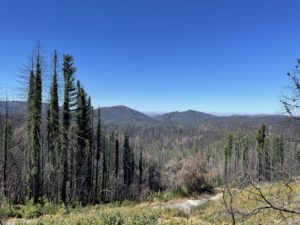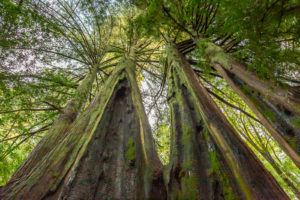o doubt about it; there’s something awe-inspiring about old-growth redwood trees. I think it has to do with our expectation that growing, living things be at a certain scale. So when we encounter a 1,500-year-old, 300-foot-tall redwood with a circumference of 70 feet—or a 200-ton adult blue whale for that matter—it trips a switch into the realm of awe. It’s probably no coincidence, then, that our region’s longest-running conservation campaign is the one to save the redwoods, which began in 1899 as these magnificent trees were being cut down at an alarming rate.
This movement has long focused on efforts to slow old-growth logging and preserve the remaining groves of these majestic trees, which grow in a fairly narrow coastal strip from southern Oregon south to Big Sur. But now, virtually all the old-growth redwoods have either been protected or cut down. More than 95 percent of our redwood forests consist of trees that are “new growth” and are devoid of the complexity and biodiversity harbored in old- growth forests. So what’s to be done?
The organizations established a century ago to protect redwoods—Sempervirens Fund and Save the Redwoods League—have begun to pivot their efforts toward managing the redwood forests we have today to become the old-growth forests of the future. And this will entail more than acquiring redwood properties and leaving them alone. In order to support the process of logged forests maturing into old-growth forests, these groups are looking at more active management that includes—perhaps counterintuitively—limited logging, both to open up windows for greater growth by the remaining trees and to fund this expensive stewardship and monitoring work. We take a look at this innovative process in the story “What’s Next for the Redwoods?” (online July 11).
Of course, humans have been actively “designing” the surrounding environment for eons: Think of the burning practices of California Indians to slow the “natural” succession of grasslands—which provided much of their sustenance—into scrub. So it’s not surprising—though it was unintentional—that this issue’s three feature articles take up the phenomenon of humans actively designing nature, though in these cases, the goal is to repair human-caused damage.
One article focuses on successful efforts by the East Bay Regional Park District to create nesting habitat—a “tern island”—for the endangered California least tern in the middle of a waste treatment pond in Hayward. Environmental engineering that offsets the loss of habitat due to shoreline development is something that everyone can get behind.
Much more controversial are efforts to protect the breeding population of the rare ashy storm-petrel (a diminutive gray seabird) on the Farallon Islands. Currently on the table is a proposal by the U.S. Fish and Wildlife service to use rodenticide to exterminate invasive house mice that are overrunning portions of Southeast Farallon and attracting burrowing owls, who then feed on the petrel eggs as well. But what if we could get rid of the mice, or other invasive species, without poisons, using genetic engineering instead? Scientists could create a mouse that would produce only male offspring and thereby breed itself out of existence in just a few generations in the island’s closed ecosystem. This is not being proposed currently, but those of us who have grave concerns about tinkering with the genetic code of living organisms need to at least consider this as an alternative to the other two unattractive options: the widespread use of poison on wildlife-rich islands, or the certain demise of the ashy storm-petrel (or some other threatened species elsewhere).
I don’t have the answer, but our work on “Re-coding for Conservation” has challenged me to start learning about this new technology and consider its implications. We’d love to hear what you think and spark a good conversation by inviting you to share your thoughts at facebook.com/baynature.
In the meantime, summer is a great time to enter the “realm of awe” by taking a hike through a shady redwood forest or taking a whalewatching tour to see the record numbers of humpbacks and blue whales foraging off our coast this summer.





